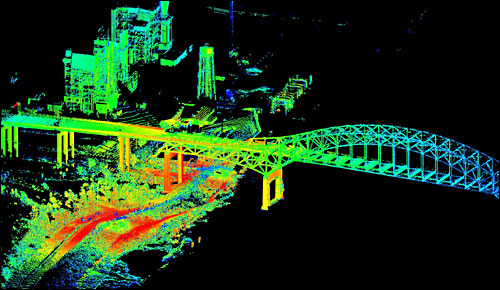
Lasers Map Hurricane Isaac Flooding
US Geological Survey scientists used a lidar technique called terrestrial lidar over the weekend to map urban flooding caused by Hurricane Isaac. “T-lidar” will enable them to collect highly detailed information in select population areas in Louisiana, Mississippi and Alabama, where the hurricane had the greatest impact.
"If a picture paints a thousands words, a T-lidar scan paints several million words to capture the fleeting aftermath of a hurricane's impact," said USGS director Marcia McNutt. "The ability to rapidly preserve for posterity a quantifiable, three-dimension representation of storm damage is going to open the doors for new flood hazard science."

This 3-D terrestrial lidar scan of the Interstate 510 bridge in New Orleans was taken Aug. 31. The US Geological Survey is using this new technology in select areas of Louisiana, Mississippi and Alabama to map flooding in urban areas affected by Hurricane Isaac. (Image: Toby Minear, USGS)
Terrestrial lidar, also called terrestrial laser scanning or TLS, uses a sensor that emits laser pulses and measures distance by how long it takes the reflected beam to "bounce back" to the instrument. TLS can provide very precise data, to millimeter accuracy, to build quick, high-resolution 3-D models of buildings, dams, levees and other structures; it also identifies areas of storm damage. In a 4- to 5-min scan, the instrument collects millions of topographic data points in a full 360° view to quickly produce highly accurate topographic information, and it can map areas up to two-thirds of a mile away.
"We are collecting storm-tide information that will allow scientists to study the impacts of the storm in three dimensions," said Toby Minear, a research hydrologist at the USGS California Water Science Center who is participating in the study. "Imagine a 360-degree panoramic photo, but made with laser points, where everything you can see has a known elevation and location. These 'point clouds' can be put together to create a full 3-D map of an area containing many millions of data points."
Because it looks sideways from ground level, T-lidar captures vertical details, such as water levels, that airborne lidar cannot. The USGS will be using both a tripod- and a truck-mounted version. While the tripod version takes individual scans from multiple locations that later have to be combined to develop its 3-D maps, the truck-mounted version continuously collects information that is available almost immediately.
"Using terrestrial lidar in this fashion has the possibility of helping us quickly assess high-water marks, current water levels and, to some degree, flood damage, in a very short time," said Athena Clark, director of the USGS Alabama Water Science Center. "We’re always looking for better, more efficient and cost-effective ways of advancing the science, and this technology has some great possibilities."
The information gathered from this pilot project will be used by USGS to develop 3-D models of streets and structures, including the levels that floodwaters reached, as well as current water levels in the form of an interactive 3-D flood inundation map. The map will help identify where the potential threat of future floodwaters is greatest and help determine the extent of wind and flood damages caused by Isaac.
Besides the use of terrestrial lidar, the USGS is planning airborne lidar flights to assess the level of coastal change caused by Isaac along the Gulf Coast. More information on both studies will be released when they are completed.
For more information, visit: www.usgs.gov
Published: September 2012